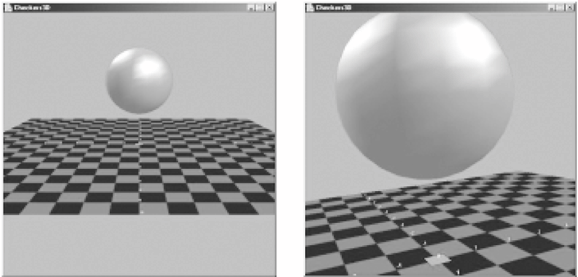Class Diagrams for Checkers3D
Chapter 15. A 3D Checkerboard: Checkers3DThis chapter describes Checkers3D with a Java 3D example that creates a scene consisting of a dark green and blue tiled surface with labels along the x- and z-axes, a blue background, and a floating sphere lit from two different directions. The user (viewer) can travel through the scene by moving the mouse. The lefthand screenshot in Figure 15-1 shows the initial view; the picture on the right shows the scene after the user has moved around a bit. Figure 15-1. Initial view, and later Checkers3D illustrates many of the common, and sometimes tricky, aspects of programming with Java 3D. For example, the 3D scene is displayed using the Java 3D Canvas3D class, which must be integrated with Java's Swing components. All Java 3D applications require a scene graph, and Checkers3D shows how to add basic shapes, lighting (ambient and directional), and a background. The scene graph diagram acts as a visual form of documentation, and a textual version of its information can be generated easily, with the help of Daniel Selman's Java3dTree package. (I'll supply details at the end of this chapter). The floor and sphere utilize Java 3D's QuadArray, Text2D, and Sphere geometry classes: the floor is a series of quadrilaterals in a QuadArray, and labels are placed along the main axes of the floor using Text2D objects. The sphere shows how a 3D shape is colored, lit, and positioned in space. The user looks into the 3D world from a viewpoint. You'll see how it can be initially positioned, and how it can be moved during execution by using Java 3D's OrbitBehavior class. |
EAN: 2147483647
Pages: 340